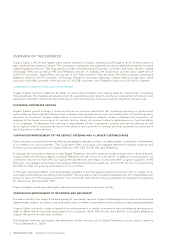Cogeco 2006 Annual Report Download - page 20
Download and view the complete annual report
Please find page 20 of the 2006 Cogeco annual report below. You can navigate through the pages in the report by either clicking on the pages listed below, or by using the keyword search tool below to find specific information within the annual report.18 COGECO CABLE INC. 2006 Management’s Discussion and Analysis
The growth in penetration of broadband connections of all types, the rapid increase in transmission speeds offered by
competitors in the market, and the emergence of the more powerful MPEG-4 video standard promote the increased
distribution and consumption of video content directly over the Internet. Video content, which is bandwidth-intensive,
already accounts for over 50% of total peer-to-peer data traffi c on the Internet. This may lead eventually to fragmentation
of the retail market for existing analog and digital video distribution services provided by the Corporation, and gradual
disintermediation as between video content suppliers and the Corporation’s customers. In this context, revenue and
margins derived from the Corporation’s HSI services may not entirely compensate for the loss of revenue or margin
derived from the Corporation’s video distribution services in the future. Alternative voice and data communications
services are proliferating as well over the Internet, with the resulting risk that fragmentation and disintermediation may
also occur in the future with respect to the Corporation’s Digital Telephony service.
Electronic communications increasingly rely on advanced security technology and devices to ensure conditional access
and service integrity. Security technology is provided worldwide by a small pool of global suppliers on a proprietary basis.
Like other providers of electronic communications, the Corporation depends on the effectiveness of security technology
for many of its services and the ability of security technology providers to offer cost-effective and timely solutions as, if and
when existing levels of security are compromised.
REGULATORY RISKS
In Canada, broadband telecommunications facilities and services are subject to regulatory requirements depending mainly
on the type of facilities involved, the incumbent status of service providers and their relative market power, the technology
used and whether the activities are categorized as telecommunications or broadcasting. Canadian cable broadband
telecommunications facilities and services are subject to various requirements mainly under federal legislation governing
broadcasting, radiocommunication, telecommunications, copyright, and privacy, and under provincial legislation governing
consumer protection and access to certain property and power utilities support structures. Licences are still required for
the operation of larger (Class 1 and 2) cable systems, while smaller (Class 3) cable systems are now mostly licence-exempt.
Various licence and licence exemption conditions continue to apply in Canada. Canadian cable operators are also subject
to Canadian ownership and control requirements.
A recently published report by the Telecommunications Policy Review Panel (TPRP) contains a broad set of recommendations
that include a timely transition to deregulation of all telecommunications services, the creation of a specialized
telecommunications competition tribunal, a review of the
Telecommunications Act
(Canada), and the removal of ownership
restrictions for telecommunications carriers, subject to certain conditions. The report also considers that the traditional
separation of broadcasting distribution and telecommunications activities for regulatory purposes is no longer appropriate
in a converged market environment. The federal government has tabled a policy direction to the Canadian Radio-Television
and Telecommunications Commission (CRTC) with a view to limiting regulation of telecommunication services as much as
possible and to relying on market forces to the maximum extend feasible, and it is expected to table a new bill on telecommunica-
tions in the near future. The federal government has also requested that the CRTC report back by the end of 2006 and
provide answers to a broad range of questions on the future of the Canadian broadcasting system, which includes the
distribution of broadcasting services.
While this overall policy review process is unfolding, two key telecommunications decisions of the CRTC concerning
respectively the regulatory status of voice-over-IP (VOIP) local access telephone services of incumbent telephone companies
and forbearance from regulation of local access telecommunications services still regulated by the CRTC have been
challenged by incumbent telephone companies. The CRTC confi rmed on September 1, 2006 its decision to continue
regulating VOIP local access telephone services of incumbent telephone companies until certain conditions are met, but has
agreed to reconsider the required threshold of 25% loss of market share by incumbent telephone companies in the relevant
markets in order for deregulation to occur. This decision may be further challenged by incumbent telephone companies.
It is not known at this time whether the federal government will require the reconsideration of, or will set aside, the decision
of the CRTC respecting regulatory forbearance for local access telephone services generally. The ultimate outcome and
timing of the policy review process and challenges to these key telecommunications decisions may have a signifi cant impact
on the development of the Corporation’s new Digital Telephony service line of business, and incidentally on the marketing
strategies for service bundles that include Digital Telephony service.
























